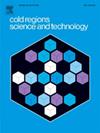奥斯塔山谷十年一次的次声阵分析:支持雪崩预报的新视角
IF 3.8
2区 工程技术
Q1 ENGINEERING, CIVIL
引用次数: 0
摘要
雪崩是全球山地环境中最致命的自然灾害之一。预报多以测量气象强迫为基础,目的是评估某一地区发生事件的概率。为了使预报模型尽可能准确,雪崩发生的信息是至关重要的。然而,实时雪崩检测仍然具有挑战性,通常仅限于雷达或视觉监视一条或几条已知的雪崩路径;这里需要新颖的监控解决方案。在过去的几十年里,次声已经被证明是一种很有前途的雪崩实时检测工具。然而,目前仍存在许多困难,主要是如何从其他自然或人为源辐射的信号中识别雪崩次声信号。在这里,我们分析了在奥斯塔山谷(意大利)海拔~ 2000米处记录的10多年次声阵列数据。我们开发了一种算法,旨在根据记录的次声检测雪崩事件,并根据现场发生的两次雪崩序列进行校准。将识别的雪崩次声信号与区域雪崩地籍报告和当地雪深数据进行比较,以测试我们算法的准确性。结果显示了良好的性能,并建议使用次声作为早期预警的辅助工具,因为它可以在视觉监视受阻时提供近实时的雪崩检测。本文章由计算机程序翻译,如有差异,请以英文原文为准。
Decennial infrasonic array analysis of snow-avalanche activity in Aosta Valley: New perspectives for supporting avalanche forecasting
Snow avalanches rank among the deadliest natural hazards in mountain environments worldwide. Forecasting is mostly based on measuring meteorological forcing, aiming at assessing the probability of event triggering in a certain area. To make forecast models as accurate as possible, information on avalanche occurrence is critical. However, real-time avalanche detection is still challenging and generally limited to radar or visual surveillance of one or a few known avalanche paths; here the need for novel monitoring solutions. In the last decades, infrasound has proven to be a promising tool for real-time detection of avalanches. However, many difficulties still exist, mostly connected to the discrimination of the infrasonic signals from avalanches among the signals radiated by other natural or anthropic sources.
Here we present the analysis of more than 10 years of infrasonic array data recorded at an altitude of 2000 m in Aosta Valley (Itay). We develop an algorithm aimed at detecting snow-avalanche events based on recorded infrasound and calibrated on two avalanche sequences that occurred in the site. The identified avalanche infrasonic signals are compared with reports of the Regional Avalanche Cadastre and with local snow-depth data to test the accuracy of our algorithm. Results reveal a good performance and suggest the use of infrasound as a supporting tool for early-warning purposes, as it could provide avalanche detection in near real-time also when visual surveillance is prevented.
求助全文
通过发布文献求助,成功后即可免费获取论文全文。
去求助
来源期刊

Cold Regions Science and Technology
工程技术-地球科学综合
CiteScore
7.40
自引率
12.20%
发文量
209
审稿时长
4.9 months
期刊介绍:
Cold Regions Science and Technology is an international journal dealing with the science and technical problems of cold environments in both the polar regions and more temperate locations. It includes fundamental aspects of cryospheric sciences which have applications for cold regions problems as well as engineering topics which relate to the cryosphere.
Emphasis is given to applied science with broad coverage of the physical and mechanical aspects of ice (including glaciers and sea ice), snow and snow avalanches, ice-water systems, ice-bonded soils and permafrost.
Relevant aspects of Earth science, materials science, offshore and river ice engineering are also of primary interest. These include icing of ships and structures as well as trafficability in cold environments. Technological advances for cold regions in research, development, and engineering practice are relevant to the journal. Theoretical papers must include a detailed discussion of the potential application of the theory to address cold regions problems. The journal serves a wide range of specialists, providing a medium for interdisciplinary communication and a convenient source of reference.
 求助内容:
求助内容: 应助结果提醒方式:
应助结果提醒方式:


